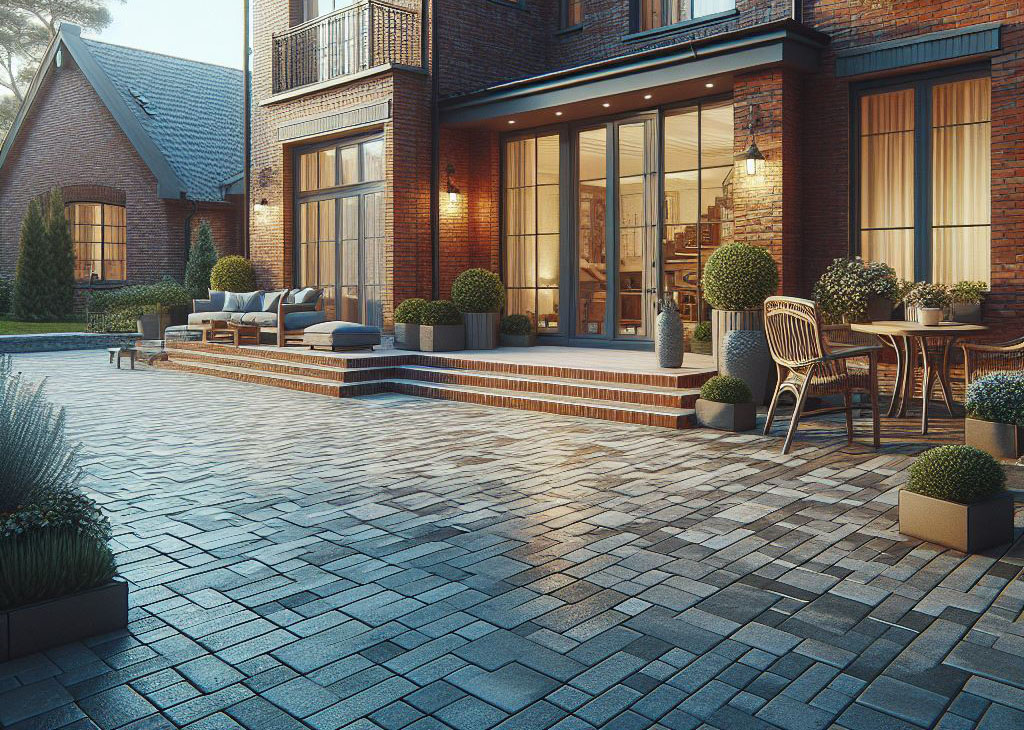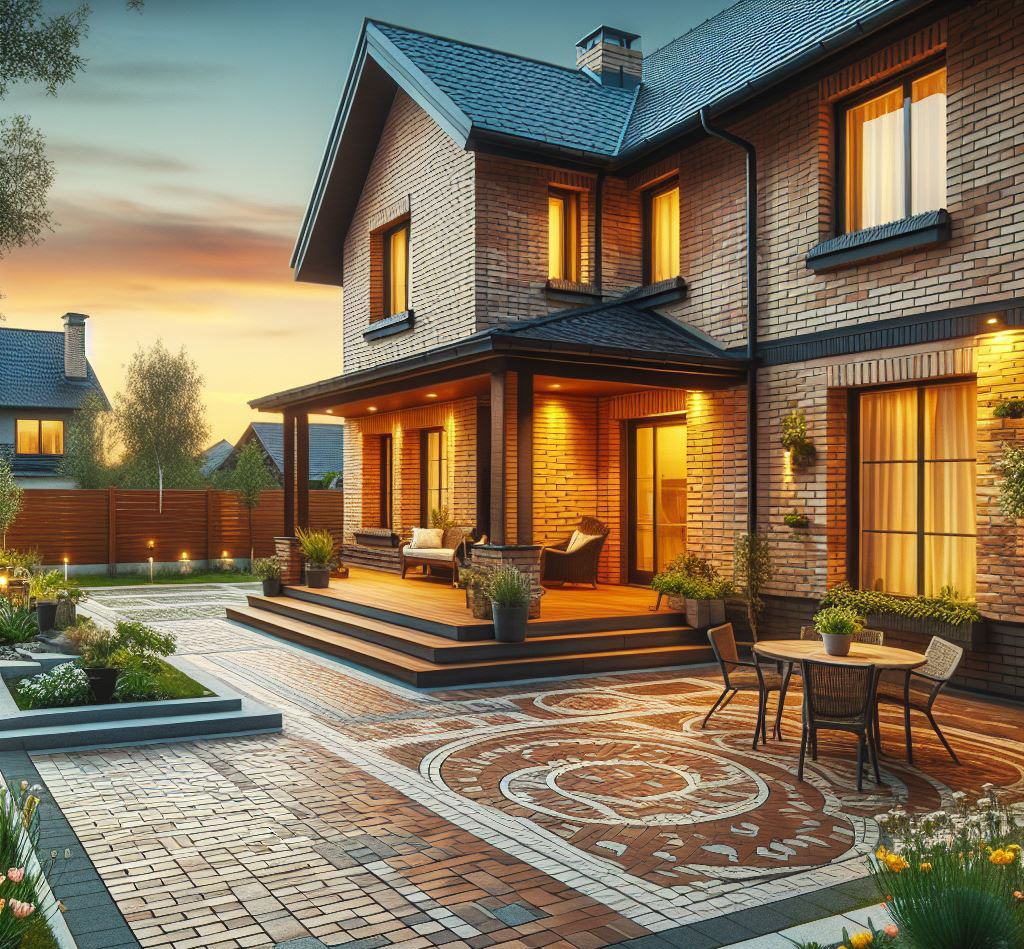In the realm of home improvement, certain elements stand as testaments to both beauty and endurance, much like brick paver patios. These structures do more than just adorn your backyard, they embed a piece of history, showcasing a craft that has been perfected over centuries. Here’s the essence of their allure:
- Timeless Charm & Durability: Brick pavers bring a certain classic sophistication to any outdoor setting. They are akin to a well-aged wine, getting better as the years pass, mainly due to their exceptional resilience against the elements. Their ability to withstand the fluctuations of weather without losing their integrity is what sets them apart.
- Value Addition: Installing a brick paver patio is not merely an addition but an investment. It enhances the aesthetic appeal and, simultaneously, the monetary value of your property. For the DIY enthusiast, it presents an opportunity to engage in a rewarding project, the fruits of which are both tangible and substantial.
- Sustainability Factor: The eco-conscious will find solace in the sustainable nature of brick pavers. Often composed of natural materials, they offer a green solution to beautifying your outdoor space. Their durability also means a reduction in replacement frequency, further cementing their position as an eco-friendly choice.

Understanding Brick Pavers
As a cornerstone of construction wisdom, the choice of materials can make or break a project. Brick pavers are a testament to this truth:
- What Are Brick Pavers? These are the building blocks of your patio. Small in size but mighty in strength, these pavers are designed to endure and grace your outdoor space with their presence for years to come. They are typically crafted through a process of kiln-firing, which imbues them with the ability to stand up to harsh conditions.
- Variety Galore: The options at your disposal are as varied as the hues of nature. From the classic warmth of terracotta to the subdued elegance of greys and browns, the palette is extensive. Shapes and sizes offer another layer of customization, ensuring that your patio is a reflection of your personal style.
- Why Brick Pavers? Their selection is not just a matter of aesthetics. Practicality plays a pivotal role – they are low maintenance, robust, and come with an inherent resistance to slippage, ensuring safety alongside beauty.

Designing Your Brick Paver Patio
The journey to a beautiful patio begins long before the first brick is laid. It starts with a vision, a plan meticulously crafted:
- Planning is Paramount: Precision in planning equates to perfection in execution. Consider the space, its usage, and the ambiance you wish to create. This phase is about envisioning the end product and charting a course to bring it to fruition.
- Style, Pattern, Color: Your patio should be a reflection of your home’s character. Whether you’re drawn to the rustic charm of a cottage-style layout or the clean lines of a contemporary design, your choice of pattern and color will set the tone. This is where your personal taste takes center stage, guiding the selection process.
- Creative Flair: The true beauty of a brick paver patio lies in its potential for customization. Consider integrating unique patterns or accentuating features like gardens or water fixtures into the design. It’s about creating a cohesive space that resonates with the essence of your home.

Preparation and Installation
Step-by-Step Guide on Preparing the Site:
- Site Marking: First things first, stake out your territory. This isn’t just about marking, it’s about envisioning the future space. Use stakes and string to outline the area meticulously. Accuracy here is paramount, it sets the stage for everything that follows.
- Excavation: Now, roll up your sleeves. You’ll need to excavate to a depth that accommodates the base, sand, and pavers. Typically, this means a dig of about 7-9 inches, but keep your local conditions in mind. Strive for uniformity in depth to avoid any unforeseen dips or rises.
- Leveling: This is where precision meets patience. Leveling the base is crucial, an uneven patio is a recipe for disaster. Use a long 2×4 and a spirit level to ensure your base is flat and subtly slopes away from any structures for proper drainage.
Detailed Instructions on the Installation Process:
- Laying the Base: Your base is the foundation of your patio. Use a sturdy material like gravel and compact it thoroughly. This isn’t just laying, it’s creating the bedrock for your pavers.
- Placing the Pavers: This is where your patio starts to come to life. Begin in a corner and lay your pavers according to your chosen pattern. Ensure they’re snug against each other for stability and aesthetics.
- Sealing Gaps: The final touch. Spread fine sand over the patio and sweep it into the cracks between the pavers. A gentle sprinkle of water helps settle the sand. Repeat this process until all gaps are securely filled.
Advice on Ensuring Proper Drainage and Maintaining a Level Surface:
- Proper Drainage: Always plan for water runoff. A gentle slope away from your house prevents water accumulation. Aim for a slope of about 1% for optimal drainage.
- Maintaining Level: Over time, pavers may shift. Regularly check and realign any pavers that have moved out of place. A rubber mallet can be your best tool for making quick, gentle adjustments.

Maintenance and Care
Best Practices for Cleaning and Maintaining Brick Paver Patios:
- Routine cleaning is key. Regularly sweeping and rinsing your pavers prevents build-up of debris and staining.
- Address stains promptly with appropriate cleaners. Quick action can prevent permanent discoloration.
Discussion on Sealing and Its Benefits for Longevity:
- Sealers are not just for aesthetics, they protect your pavers from stains and weather damage. Think of it as a shield, enhancing the durability and color of your pavers.
Tips on Dealing with Common Issues Like Weeds or Shifting Pavers:
- To combat weed growth, consider using polymeric sand in the joints. It solidifies to create a barrier against weeds and pests.
- If pavers begin to shift or sink, it may indicate issues with your base. Addressing this promptly can prevent larger issues down the line.
Cost Considerations
Overview of the Cost Factors Involved in Installing a Brick Paver Patio:
- Be mindful of the costs of materials. Pavers, sand, gravel, and any necessary equipment rental can add up quickly.
- Labor costs can be significant. However, taking on parts of the project yourself can provide savings. Ensure you’re fully prepared for the tasks you choose to tackle.
Tips on Budgeting and Saving Costs Without Compromising Quality:
- Price shop for materials, but also consider quality. Lower upfront costs can sometimes lead to higher expenses in the long run.
- Consider renting equipment instead of purchasing. For one-time use, this can provide significant savings.
Mention of the Long-Term Value and Cost-Effectiveness of Brick Paver Patios:
- A well-constructed brick paver patio can offer years of enjoyment and add value to your property. It’s an investment that pays dividends in both functionality and aesthetics.
FAQ Section
Absolutely. Properly installed and maintained pavers can endure severe weather, from scorching heat to freezing cold. Regular maintenance and appropriate sealing can further enhance their resilience.
Regular, simple maintenance can keep your patio looking pristine. Sweeping, occasional rinsing, and periodic sealing are the main tasks you’ll need to schedule.
Indeed, they are. Brick pavers are often made from natural materials and can be recycled, making them an environmentally responsible choice for your landscaping needs.
It’s possible, but requires additional groundwork. Properly preparing and leveling the base is essential to ensure stability and longevity of your patio.
The use of polymeric sand in the joints can greatly reduce weed growth. It hardens to form a barrier that deters weeds and insects, keeping your patio clean and stable.
